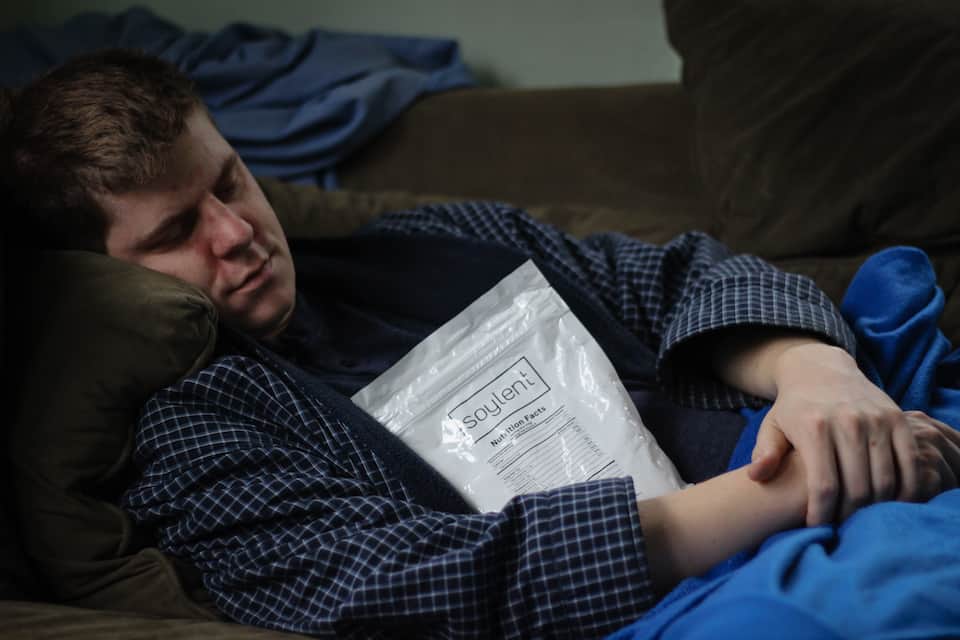Freeze dried astronautical ice cream was one of the greatest disappointments of my childhood. I was so excited to try it — after all, as a child, astronauts and ice cream were two subjects that stood firmly on hallowed ground. I remember biting into it and feeling betrayed; science had ruined two of my most cherished things. Recently, when I decided to try Soylent, I was excited to taste the latest in food-tech. I didn’t bother to recall the dehydrated ice cream incident. I probably should have.
The Soylent came in a white minimalist vacuum sealed package with black print. The package contained 2,000 calories, weighed 460 grams, was covered front and back with daily values of a variety of nutrients, displayed a list of ingredients that contained an extensive collection of polysyllabic compounds, and a short series of directions.
The directions were simple: mix the powder with water and keep refrigerated. The powder resembled a very fine sand and when mixed with water produced a sludge-like consistency. It tasted like I imagine liquefied dough would taste — with just a touch of sugar. The slightly sweet aftertaste became progressively more noticeable as my palate became increasingly starved of variety.
The press kit available from the Soylent website claims that it is “a pioneer in food technology, delivering engineered staple meals that provide all the essential nutrients required to fuel the human body.” The same kit also states that Soylent “provide[s] maximum nutrition” and that “its nutritional makeup is comprehensive.” While all this sounds rather impressive, what’s missing from their provided documentation is any promise that this product is a decent replacement for food.
For example, it doesn’t say anywhere that Soylent is a sufficient source of sustenance, although the commercial on their website would seem to indicate as much. Perhaps part of the reason why Soylent dances around making claims is that the Canadian Food Inspection Agency has clear cut quantitative checks on what type of statements can be made about how much of a given element is in a particular product; the only claims legally allowable are that something ‘contains X,’ that something is ‘high in X,’ or that something is ‘very high in X.’ There is no category for complete sources of a given nutrient.
My experience with Soylent left me exhausted. I calculated my caloric intake using the app on the Soylent website, and the first day I decided to drink my calories in three ‘staple’ meals a day. The three and a half cups of thick liquid per meal sat like a rock in my stomach; each time requiring a period of recuperation, followed by hunger, and then inexorably the next dose. The following days I sipped slowly at the sludge, which meant lugging two litres of liquid around with me everywhere I went and teetering just this side of hungry, never quite full. I slept through two appointments in two days; getting out of bed was a genuine challenge.
[pullquote]My experience with Soylent left me exhausted.[/pullquote]
Either the calorie calculation was off, or the product is just not calibrated for active students. As a commuting student, I am seldom home and carrying premixed liquid around in my backpack wasn’t feasible. The alternative is of course mixing as you go, which in retrospect would have been easier, still the packages of powder would have had to be carried with me. The lack of energy made doing anything other than being nominally present in class unrealistic. If it were the case that I was simply not drinking enough Soylent then solving the problem would only add to the inconvenience of being tethered to an even larger bottle of liquid.
There are other considerations, or circumstances in a healthy life, for which the exclusive use of Soylent would not suffice. Engaging in exercise which requires replenishing protein to either facilitate muscular regeneration or muscle growth would require a food source beyond what Soylent could provide. Similarly, it is unclear whether or not Soylent’s recommended daily intake approach to vitamins and minerals should be encouraged. It is widely accepted that an above average intake of certain compounds can reduce or prevent a variety of ailments, for example, vitamin D and omega-3 are thought to help with depression, and vitamins A-E help ease inflammation.
It is conceivable that Soylent may provide an excellent meal replacement strategy when augmented by food; however, as a fundamental shift in how we eat, especially as students, it does not provide added nutritional benefit to eating well. Furthermore, it may very well be that like endurance sports or weight lifting, academic performance requires more than just the bare minimum of nutritional sustenance.


